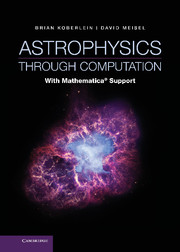1 - Introduction
Published online by Cambridge University Press: 05 June 2014
Summary
Astrophysics draws upon a wide range of topics in astronomy and physics. Topics as widely ranging as observational techniques, thermodynamics, and general relativity are all central to the material covered in this text. Many readers, particularly undergraduate students, will have only passing experience with some of these foundational concepts. It is impossible for us to provide a comprehensive review of these within the scope of this text, but we begin with a basic overview of the most central topics necessary to approach the astrophysical subjects to be covered. In later chapters we build on these various terms in greater detail. Although we do assume more than a general background in physics and astronomy, we do not provide a comprehensive discussion of the basics, as these can be obtained elsewhere. Instead we present only those more advanced background concepts as needed to the task at hand.
Fundamental stellar properties
One of the central goals of astronomy is the specification of the properties of the sun, stars, and other self-luminous bodies in the universe. Learning about the ranges of these properties and how the quantities characterizing them are determined are a major part of any astronomy course, so we only briefly discuss them here.
Cosmic distance scales
The most fundamental property of a celestial object is its distance from another body. Usually the reference is the sun, the star nearest to Earth. Within the solar system, distances are specified using astronomical units (AU), equal to the mean distance between Earth and sun. Outside the solar system, distances are so large that one immediately switches to another unit, the parsec. The parsec was devised when distances to stars were first measured by the method of trigonometric parallax, and distance was determined from the annual shift of an object’s angular position in the sky.
- Type
- Chapter
- Information
- Astrophysics through ComputationWith Mathematica® Support, pp. 1 - 28Publisher: Cambridge University PressPrint publication year: 2013

